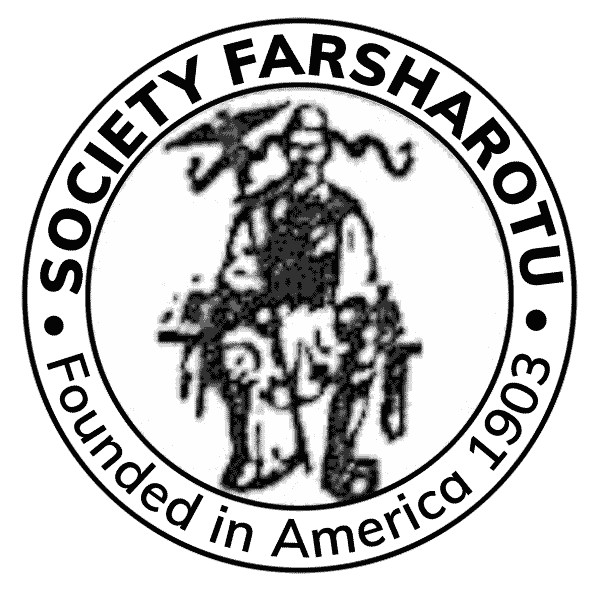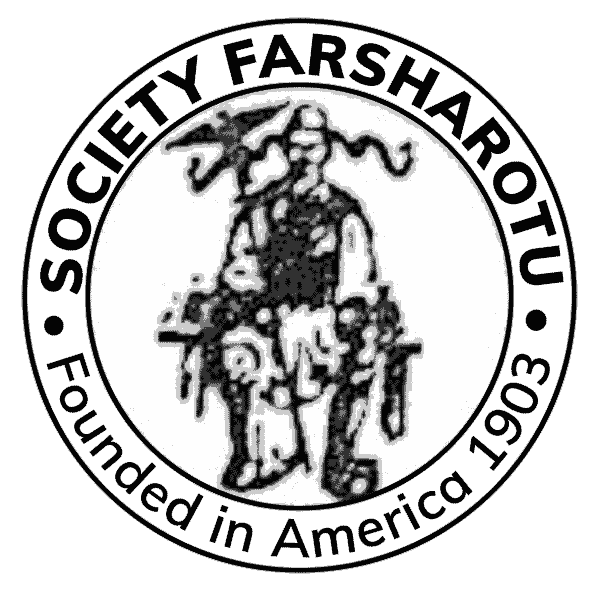History of the Society Farsarotul
While benevolent societies have existed for many centuries, the specific roots of the Society Farsarotul may lie in the guild system of Ottoman cities. Guilds were groups of men in similar professions who banded together for their mutual support. When the Ottomans conquered the Balkans, the Turkish religious brotherhoods (akhi) took over the existing Balkan guilds, thereby adding a social-moral dimension to their usual economic function. Thus guilds also became benevolent societies, helping the needy among the members and their families (especially widows and orphans) and seeing to their decent burial. The Turkish word for the guild of small merchants and tradesmen, esnaf, was even incorporated into the Aromanian language (isnafi, “group”).
The young men who emigrated to the United States in the latter part of the 19th century and the early part of this century were familiar with this particular type of benevolent society and probably used it as a model. After establishing themselves in America, they founded a benevolent society of their own to see to the needs of our people here. The first page of our Archives indicates that the following group of young men living in New York City banded together under the leadership of our founder, Nicola Cican, to initiate what is today the Society Farsarotul: Spiru Cican, Nasta Cican, Dina Cican, Hrista L. Carabina, Dimitri St. Carabina, and Ilie Culetsu.
The Benevolent Society, known then as “Sperantsa” (Hope), officially was founded on September 15, 1903. Nicola Cican went back to Europe that year and upon his return to the United States he settled in St. Louis where many of our young men then resided. On October 13, 1904, a general meeting was held in St. Louis and the first local branch of the Society was established. During the balance of that year no dramatic growth was recorded, but by 1905 the Society began to accumulate funds, maintain accounts, and conduct itself in a manner similar to the benevolent societies in Europe. On December 10, 1906, the Society Sperantsa officially changed its name to the Society Farsarotul. On that date, the Society’s assets totaled $350.
Over the next two years, branches were opened in North Grosvenordale and Bridgeport, Connecticut. On February 8, 1908, a local branch was established in Woonsocket, Rhode Island, and later that year groups were established in Central Falls, Rhode Island, and in San Francisco, California. By the end of 1908 there were seven active branches of the Society including the headquarters in New York.
In 1909 a division occurred among the members. While the Archives are silent about the nature of the dispute, problems continued for seven years. In March of 1913 the headquarters of the Society were moved from New York to Woonsocket and in September of that year a group of 13 members composed a document which attempted to resolve the problem. A general meeting was then held on September 14 but apparently the difficulty remained unresolved.
In order to put an end to the strife the members decided to appoint a commission, which met on June 17, 1916. There were representatives sent from each branch, including Dimitrie Simu from Bridgeport, Hrista Vasilescu from North Grosvenordale, George Shanazu from St. Louis, and Spiru Mushi and Ioan Popescu from the central headquarters in Woonsocket. The commission met over the next week and ultimately signed a report on June 24, 1916, indicating that the controversy was resolved but that because the division had been so deep, all references to it were to be deleted from the Society’s Archives.
From its humble beginning in 1903 the Society grew to 201 members by 1909. Over the next ten years the membership doubled. By 1919 the organization’s membership had reached 400 and its assets were $6,025.00.
In 1918 a decision was made to change the seal of the Society, which up until then had borne the portrait of founder Nicola Cican. Rather than show a particular individual, a generic drawing of a typical Aromanian in full costume was to be substituted, though it was eight years before the change was implemented.
During the decade of the twenties the Society continued its efforts to assist persons of Aromanian descent. The Archives show that in 1920 the Society was sending $50. annually to an orphan living in Rumania to assist in her schooling. In 1926 the Society sent money to a family residing in Korytsa, Albania, whose members were all suffering from tuberculosis.
During the following decade the Society Farsarotul was affected by the economic depression which gripped both old country and new. The Society established a loan program to assist members in facing their economic difficulties. In most cases the Society made the loans at very low interest rates and only requested the payment of interest where it could be afforded. The dues payments were reduced but nevertheless dues still often proved a burden and by 1936 the records show only 141 active members, a dramatic reduction from the 1919 figures. The capital assets at the end of 1936 totaled $17,994.76, which included cash on hand, loans to members, and a $2,000. loan made to build a new church in Korytsa, Albania (this loan was later written off as a donation). By that same year the chapters in Central Falls and San Francisco were inactive and the one in St. Louis was down to six active members. The core of the Society rested in its communities in New York, Bridgeport, North Grosvenordale, and Woonsocket.
There was slow growth in membership during the latter part of the 1930s, up to 151 by 1941, but then in 1942©43 an active recruitment campaign brought total membership up to 300. The increases were largely in the Bridgeport and Woonsocket chapters with the membership in the others remaining constant. The net worth of the Society had increased to $20,077.56.
During the war years membership dues were suspended for those on active duty. In 1946 the Society celebrated the Allied victory by holding a Grand Victory Ball at the Paramount Mansion in New York City on May 4, 1946. Admission, including dinner and dancing, was $1.50.
The Society’s Fiftieth Anniversary Ball was held in 1953 at the Biltmore Hotel in New York. There were still four active chapters. The central committee was located in New York and district committees existed in Woonsocket, Bridgeport, and North Grosvenordale. St. Louis membership had declined to the point where that community only participated through a representative. During this period the Society was rotating its annual affairs in the various cities where its active members resided. In 1955, for example, the annual ball was held at the Dreyfus Hotel in Woonsocket.
The Fiftieth Anniversary Ball also celebrated the Society’s unselfish donation in its first 50 years of some $10,000., a substantial portion of its assets. Much of this money went towards the construction of houses of worship for Aromanians the world over (in fact, the Society often provided the first large donation to kick off church fundraising efforts), including the churches in Korytsa, Albania; Neveska, Greece; Frasari, Rumania; and in America, the churches in Woonsocket, RI; Bridgeport, CT; Southbridge, MA; Manhattan, NY; and Worcester, MA. In most cases, sadly, the key role played by the Society in the establishment of these churches is now largely forgotten. By 1960 the net worth of the Society had increased to $66,864.42. We lost many old-time members during the first four years of that decade. The Society was nevertheless able to increase its assets through fundraising efforts and donations.
During the 1970s the Society underwent many adjustments in response to both demographic changes and the Americanization of its membership. In 1974, for example, the enormous task of translating the By-Laws into English was accomplished. The headquarters of the Society were transferred from New York to Bridgeport, where the largest Aromanian community continued to exist. By 1979 the By-Laws were revised to eliminate the local committees. The Society now operated with one central administrative committee, which resulted in a more streamlined operation of the organization.
In the latter part of the present decade the Society has revived and even expanded. A permanent office has been established in Bridgeport, Connecticut. That office is built so as to allow for a small reference library eventually. The records of the Society have now been computerized, and a Newsletter has been created to keep in touch with our far-flung membership. We have also awarded a grant to a leading scholar of the Aromanians, Prof. Tom J. Winnifrith, so that he may inventory the films of the Manakia brothers, Aromanians from Avdhella who were the first cinematographers in the Balkans and who recorded the way of life in our villages just before that way of life disappeared forever.
The most important effort of the Society recently has been its campaign to broaden and increase its membership. At this time we have a total of some 260 active and matured members. It is the hope of the Society’s leadership that membership will continue to grow and that the Society can thereby continue to pass on to our people the best of the culture that has sustained us for two millenia.
Robert J. Nicola is a graduate of Franklin & Marshall College where he majored in History. After graduating from the University of Connecticut Law School in 1967 he commenced his law practice in Bridgeport, CT, where he is a partner in the firm of Owens, Schine, Nicola and Donahue. Mr. Nicola was a member of the Connecticut Indian Affairs Council for nine years and has been active in the Town of Easton where he has served as the Chairman of the Conservation Commision as well as Town Attorney. He has been a member of the Society Farsarotul for over 20 years.


Responses